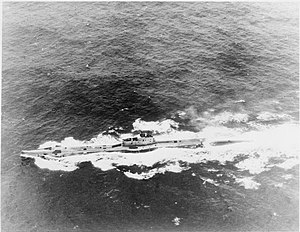 HMS Triumph
| |
| History | |
|---|---|
| Name | Triumph |
| Builder | Vickers Armstrong, Barrow |
| Laid down | 19 March 1937 |
| Launched | 16 February 1938 |
| Commissioned | 2 May 1939 |
| Identification | Pennant number N18 |
| Fate | Sank December 1941–January 1942 |
| Badge |  |
| General characteristics | |
| Class and type | British T class submarine |
| Displacement |
|
| Length | 275 ft (84 m) |
| Beam | 26 ft 6 in (8.08 m) |
| Draught | 16.3 ft (5.0 m) |
| Propulsion |
|
| Speed |
|
| Range | 4,500 nautical miles at 11 knots (8,330 km at 20 km/h) surfaced |
| Test depth | 300 ft (91 m) max |
| Complement | 64 |
| Armament |
|
HMS Triumph (N18) was a T-class submarine of the Royal Navy. She was laid down by Vickers at Barrow-in-Furness and launched in 1938. The boat was lost in transit in 1942, with a crew of 64, and its fate was unknown until the sunken boat was rediscovered in June 2023.
Career
At the onset of the Second World War, Triumph was a member of the 2nd Submarine Flotilla. From 26–29 August 1939, the flotilla deployed to its war bases at Dundee and Blyth. [1]
Home waters

On 26 December 1939, Triumph hit a German mine in the North Sea. She lost 18 feet (5.5 m) of her bow when it was blown off. Her pressure hull was also damaged, but her torpedoes did not detonate. She managed to limp home under the protection of fighter aircraft and destroyers, and was under repair at Chatham Dockyard until 27 September 1940.
Mediterranean
Operating in the Mediterranean from early 1941, Triumph sank the Italian merchants Marzamemi, Colomba Lofaro, Ninfea, Monrosa, the Italian auxiliary patrol vessels V 136 / Tugnin F, Valoroso, V 190 / Frieda and V 137 / Trio Frassinetti, the Italian tug Dante de Lutti and salvage vessel Hercules, the German merchant Luvsee, and the Greek sailing vessels Panagiotis and Aghia Paraskevi. She also damaged the Italian armed merchant cruiser Ramb III, the Italian tankers Ardor and Poseidone, the Italian merchant Sidamo and the German merchant Norburg
In June 1941 she sank the Italian submarine Salpa near northern Egypt.
Sinking and discovery
Triumph was also used for covert operations, such as landing agents in German-occupied areas. She was planned to be used as a rendezvous for commandos in Operation Colossus, but this had to be cancelled when the landing site became untenable. She undertook one such mission in December 1941, in which she successfully landed agents at Antiparos, Greece on the 30th. She failed to pick up the agents as scheduled on 9 January, and was lost probably to a collision with a mine. All sixty-four crew were lost. [2] [3] A memorial plaque to the boat and her lost crew members was placed in All Saints' Church, Lindfield, West Sussex.
In June 2023 Greek researchers led by Kostas Thoktaridis discovered the lost submarine in the Aegean Sea at a depth of 203 metres. The submarine rests on the seabed of the open sea with an 8-degree starboard list, dozens of kilometres away from the shores of Sounion. The lowered periscopes and sealed hatches testify that the Triumph was in a deep dive during its final moments. The diving planes and rudder are in a straight position, indicating that it was at a steady depth. [4]
References
Citations
- ^ Rohwer, p.1
- ^ Submarine losses 1904 to present day Archived 8 August 2007 at the Wayback Machine, RN Submarine Museum, Gosport
- ^ "HMS Triumph (+1942)". Wrecksite. Retrieved 12 May 2023.
- ^ Newsroom (8 June 2023). "Greek diver discovers long-lost British World War II submarine | eKathimerini.com". www.ekathimerini.com. Retrieved 8 June 2023.
Sources
- Colledge, J. J.; Warlow, Ben (2006) [1969]. Ships of the Royal Navy: The Complete Record of all Fighting Ships of the Royal Navy (Rev. ed.). London: Chatham Publishing. ISBN 978-1-86176-281-8.
- Frampton, Viktor & Domenico, Francesco de (2015). "Question 13/51: British Submarine Actions of WW II". Warship International. LII (2): 116–118. ISSN 0043-0374.
- Hutchinson, Robert (2001). Jane's Submarines: War Beneath the Waves from 1776 to the Present Day. London: HarperCollins. ISBN 978-0-00-710558-8. OCLC 53783010.
- Rohwer, Jürgen (2005). Chronology of the War at Sea 1939–1945: The Naval History of World War Two (Revised & Expanded ed.). Annapolis, Maryland: Naval Institute Press. ISBN 1-59114-119-2.
- British T-class submarines of the Royal Navy
- Ships built in Barrow-in-Furness
- 1938 ships
- World War II submarines of the United Kingdom
- Maritime incidents in December 1939
- Ships sunk by mines
- World War II shipwrecks in the Mediterranean Sea
- Maritime incidents in December 1941
- Maritime incidents in January 1942
- Submarines lost with all hands